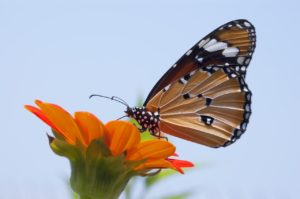Monarch Butterflies

This part of my site will be focused on our journey supporting Monarch Butterflies.
My wife and I have always been fascinated by all of God’s works, from the creation of the universe to the birth of our children, and everything in between. My wife’s passion is wildlife photography and her skills with digital cameras have produced some amazing images of wildlife in Kenya and Tanzania, Costa Rico, Galapagos and our own backyard. Last summer, she became interested in butterflies when we purchased a plant from the local nursery and it contained two beautiful caterpillars, which we named Bill and Phil. The nursery folks explained that these were Black Swallowtail caterpillars and that they would go through their cycles of change and become Black Swallowtail butterflies. Phil eventually wandered off, but Bill stayed with us on his Rue plant, feeding on it until time for him to form his Chrysalis, and then hatch. As we watched him fly away, I knew my wife was hooked on these little miracles of God.
For 2018, we were very intentional about creating a pollinator habitat that would be especially attractive to Monarch Butterflies, which we understood to be in decline due to several issues, including loss of habitat supporting their difficult lifecycle. So, in April of this year, we began planting the required Milkweed and Butterfly Bushes to attract, feed and support the 2018 Monarch season here in Virginia. And while all of these plants attracted a great throng of hummingbirds, bees and other pollinators, it was the Monarch experience that will be the focus of this blog, as seen through my wife’s eyes and the lenses of her digital SLR. In the course of the summer and early fall, she would learn a tremendous amount about the life cycles of these incredible creatures, including how to perform surgeries on the wings of several damaged individuals. In this part of my site, you will find observations, photos, videos, and helpful advice for any who want to become involved in supporting these insects and their fascinating life-cycle, which at first glance would seem impossible to sustain.
But before we get into the experience of attracting, and supporting Monarch Butterflies, here are some facts and figures to set the context of our journey according to https://en.wikipedia.org/wiki/Monarch_butterfly :
1).The monarch butterfly or simply monarch (Danaus plexippus) is a milkweed butterfly (subfamily Danainae) in the family Nymphalidae.
2).Its wings feature an easily recognizable black, orange, and white pattern, with a wingspan of 8.9–10.2 cm (3 1⁄2–4 in)
3).The eastern North American monarch population is notable for its annual southward late-summer/autumn migration from the northern and central United States and southern Canada to Florida and Mexico.[4] During the fall migration, monarchs cover thousands of miles, with a corresponding multi-generational return north. The western North American population of monarchs west of the Rocky Mountains often migrates to sites in southern California but has been found in overwintering Mexican sites as well
4). Monarchs were transported to the International Space Station and were bred there.